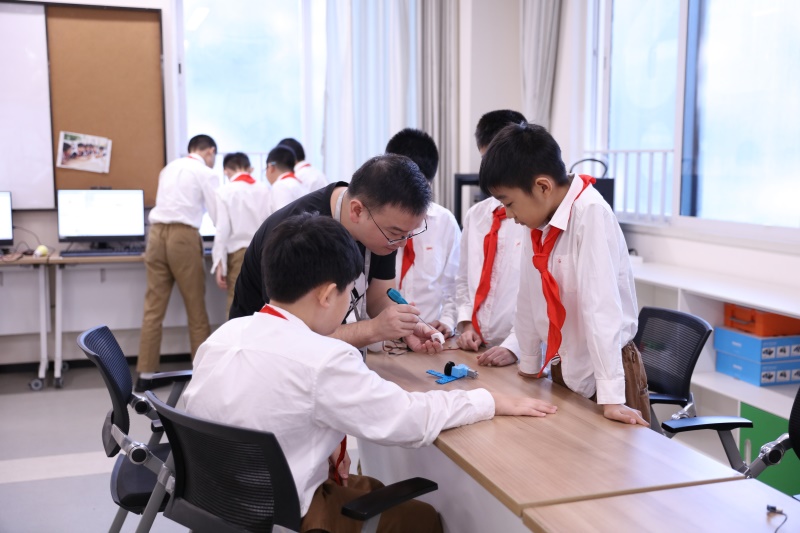 新闻详情
新闻详情
 新闻详情
新闻详情
万双网讯 11月11日和11月16日,万科双语学校STEAM教室里亮起了一道道七彩的灯光!人工智能学科与科学学科的老师历经一个多月的精心筹划,分别在五年级的两个班级开展了《发电机之能量守恒》跨学科融合实践课程。
VBS News Net: There were colorful lights seen in VBS STEAM classroom on 11th November and 16th November. After a month's planning by AI and Science teachers, inter-disciplinary course 'Generators - Principle of Energy Conservation' was delivered to Primary 5 classes.


本次课程的教学目标是让学生们理解能量守恒,了解发电机与电动机的区别,学会动手制作发电装置,并通过编程实现发电机运转,让灯泡亮起来。课程由两部分组成:第一部分由科学老师赵芮负责理论课程教学,从能量守恒定律的角度讲解该作品的工作原理,使学生对抽象的能量转换过程感受深刻。接下来对电动机和发电机进行对比探究,发现发电机与电动机在结构上没有本质的区别,只是使用方式和功能不同。第二部分是实践课程,由人工智能老师彭平执教,彭老师从发电机运作的角度,为学生们讲解搭建发电装置的方法,通过图形化编程,实现电动机转动带动发电机发电,从而让灯泡亮起来,指导学生进行实践操作。
The objective of this class was to allow students to understand principle of energy conservation, differentiate between generators and motors, DIY generator device and use programming to make it work to provide energy for light bulbs. This class was divided into two parts - theory and practice. The theory was taught by Mr. Zhao Rui who explained the working principles of generators via principle of energy conservation to understand the abstract process of energy conversion. He then conducted comparative research between motors and generators to find out that they had the same structure but different functions. The practice part was taught by Mr. Peng Ping who explained the methods from the perspective of working principles of generators to build generator devices via graphics programming to achieve generation of electricity so that light bulbs would receive electricity. He guided students on the practical operation.




在实践体验中,孩子们充分发挥自己的想象力和创造力,在不断的尝试中完成了项目制作。课程激发了同学们学习的内驱力,很多小组还在课上自主探索,进行了超越课程目标的创意编程。比如原本只要灯亮起来即算完成任务,但同学们利用编程,为灯光增加了七彩的颜色或增加了音效。在最后的展示环节,各小组纷纷上台演示作品,并说明了各自作品的创意,教室里“亮”起了一道道七彩的灯光,孩子们的眼里闪烁着快乐的喜悦与智慧的光芒。
During the practical experience process, students utilised their imagination and creativity to finish their production by trials. This course motivated students to study as they conducted independent research to perform programming which exceeded the curricular objectives. Students outperformed their tasks by adding colors and musical effects in their programming section. During the final presentation, they presented their work and explained their originality by colorful lights in the classroom to share their happiness and wisdom.















万科双语学校一直在探索先进的教学理念和方法,PBL和STEAM是学校核心教学法。目前已设计了涉及4到8年级的STEAM项目。通过融合教学,带领学生在STEAM教室完成作品的制作,以学科核心概念和高阶认知策略为目标,让学生经历丰富多彩的实践活动,促进学生的全面发展。
VBS has been exploring advanced teaching methodologies and concepts as PBL and STEAM are two core teaching methods that have been used to teach STEAM projects for Primary 4, 5 and Junior Secondary 1, 2 classes. This inter-disciplinary teaching allows students to achieve all-rounded development by experiencing a variety of practical activities and making items in class based on the objective of higher order cognition strategy and core concepts from various subjects.
文/彭平
审核/吴萍
图/燕子
翻译/赖丁慈
Author: Peng Ping
Reviewed by Ms. Pamela Wu
Photographer: Linda
Translated by DC Lai
万双网讯 11月11日和11月16日,万科双语学校STEAM教室里亮起了一道道七彩的灯光!人工智能学科与科学学科的老师历经一个多月的精心筹划,分别在五年级的两个班级开展了《发电机之能量守恒》跨学科融合实践课程。
VBS News Net: There were colorful lights seen in VBS STEAM classroom on 11th November and 16th November. After a month's planning by AI and Science teachers, inter-disciplinary course 'Generators - Principle of Energy Conservation' was delivered to Primary 5 classes.


本次课程的教学目标是让学生们理解能量守恒,了解发电机与电动机的区别,学会动手制作发电装置,并通过编程实现发电机运转,让灯泡亮起来。课程由两部分组成:第一部分由科学老师赵芮负责理论课程教学,从能量守恒定律的角度讲解该作品的工作原理,使学生对抽象的能量转换过程感受深刻。接下来对电动机和发电机进行对比探究,发现发电机与电动机在结构上没有本质的区别,只是使用方式和功能不同。第二部分是实践课程,由人工智能老师彭平执教,彭老师从发电机运作的角度,为学生们讲解搭建发电装置的方法,通过图形化编程,实现电动机转动带动发电机发电,从而让灯泡亮起来,指导学生进行实践操作。
The objective of this class was to allow students to understand principle of energy conservation, differentiate between generators and motors, DIY generator device and use programming to make it work to provide energy for light bulbs. This class was divided into two parts - theory and practice. The theory was taught by Mr. Zhao Rui who explained the working principles of generators via principle of energy conservation to understand the abstract process of energy conversion. He then conducted comparative research between motors and generators to find out that they had the same structure but different functions. The practice part was taught by Mr. Peng Ping who explained the methods from the perspective of working principles of generators to build generator devices via graphics programming to achieve generation of electricity so that light bulbs would receive electricity. He guided students on the practical operation.




在实践体验中,孩子们充分发挥自己的想象力和创造力,在不断的尝试中完成了项目制作。课程激发了同学们学习的内驱力,很多小组还在课上自主探索,进行了超越课程目标的创意编程。比如原本只要灯亮起来即算完成任务,但同学们利用编程,为灯光增加了七彩的颜色或增加了音效。在最后的展示环节,各小组纷纷上台演示作品,并说明了各自作品的创意,教室里“亮”起了一道道七彩的灯光,孩子们的眼里闪烁着快乐的喜悦与智慧的光芒。
During the practical experience process, students utilised their imagination and creativity to finish their production by trials. This course motivated students to study as they conducted independent research to perform programming which exceeded the curricular objectives. Students outperformed their tasks by adding colors and musical effects in their programming section. During the final presentation, they presented their work and explained their originality by colorful lights in the classroom to share their happiness and wisdom.















万科双语学校一直在探索先进的教学理念和方法,PBL和STEAM是学校核心教学法。目前已设计了涉及4到8年级的STEAM项目。通过融合教学,带领学生在STEAM教室完成作品的制作,以学科核心概念和高阶认知策略为目标,让学生经历丰富多彩的实践活动,促进学生的全面发展。
VBS has been exploring advanced teaching methodologies and concepts as PBL and STEAM are two core teaching methods that have been used to teach STEAM projects for Primary 4, 5 and Junior Secondary 1, 2 classes. This inter-disciplinary teaching allows students to achieve all-rounded development by experiencing a variety of practical activities and making items in class based on the objective of higher order cognition strategy and core concepts from various subjects.
文/彭平
审核/吴萍
图/燕子
翻译/赖丁慈
Author: Peng Ping
Reviewed by Ms. Pamela Wu
Photographer: Linda
Translated by DC Lai
办学理念:让孩子站在未来中央
培养(成长)目标:培养(成为)身体健康、人格健全、学力卓越,具有家国情怀和国际视野, 敢于创造美好未来的中国公民。
地址:深圳市龙华区民治街道华南路80号
电话:0755-66866333
http://vbs.vanke.com
Vanke Bilingual School, Longhua District, Shenzhen
Educational Idea: Let our children experience the future.
Training objectives: our students will become citizen of China with good physical health, sound personality, excellent academic abilities, patriotism, international vision and the courage to create a better future.
Address: No.80 Huanan Road, Minzhi Sub-district, Longhua District, Shenzhen
Contact: 0755-66866333
http://vbs.vanke.com

学校网站二维码
QR code of school website
学校公众号二维码
QR code of school official account